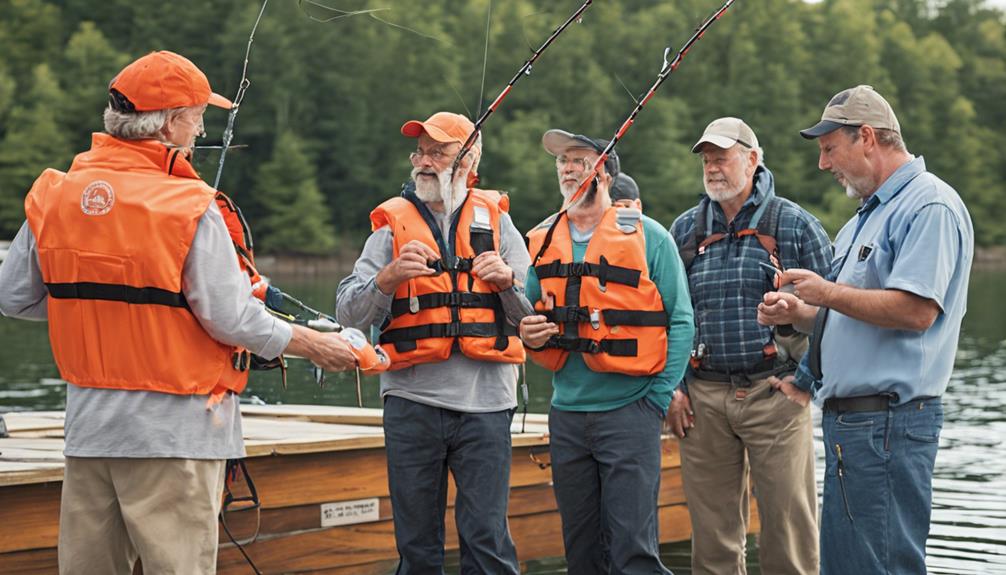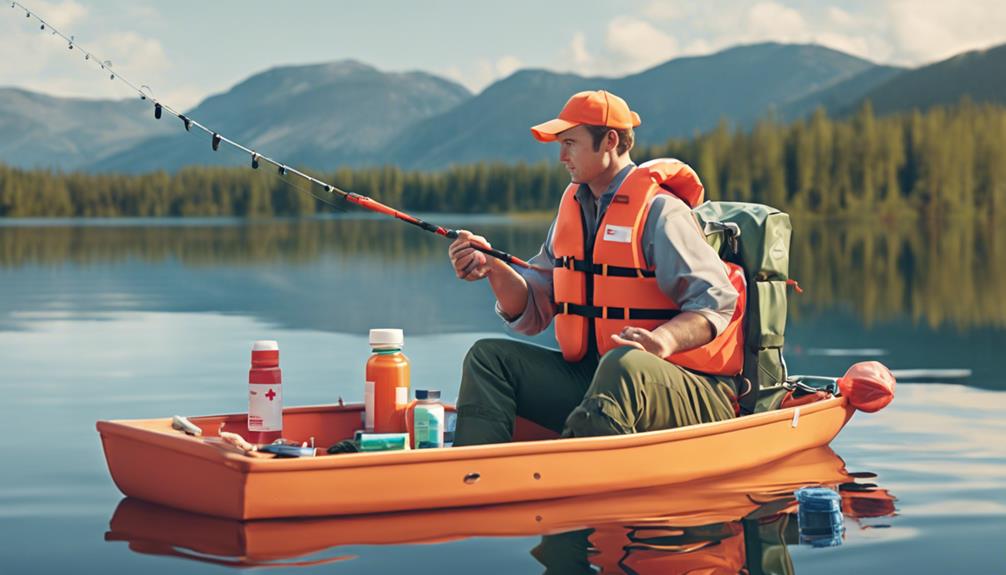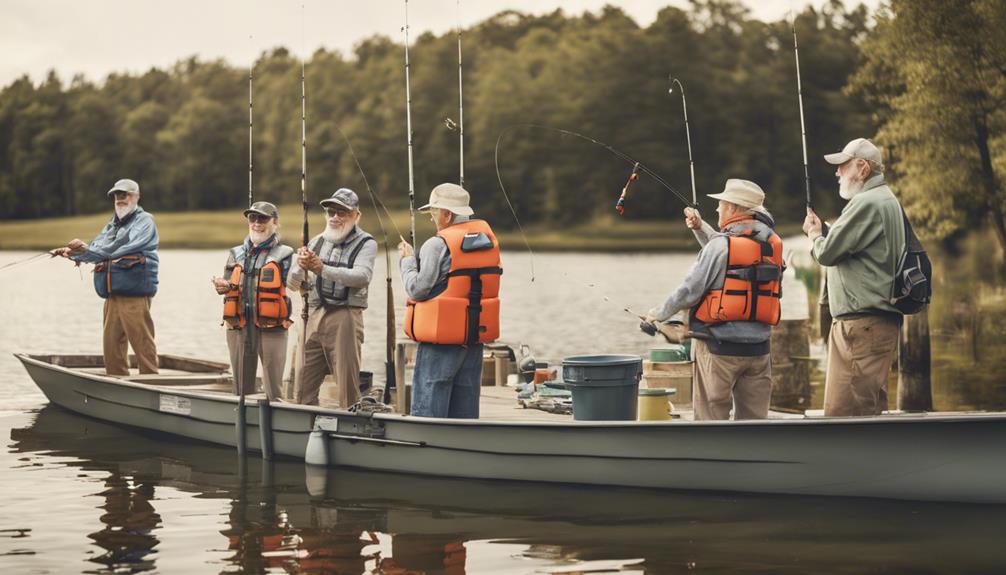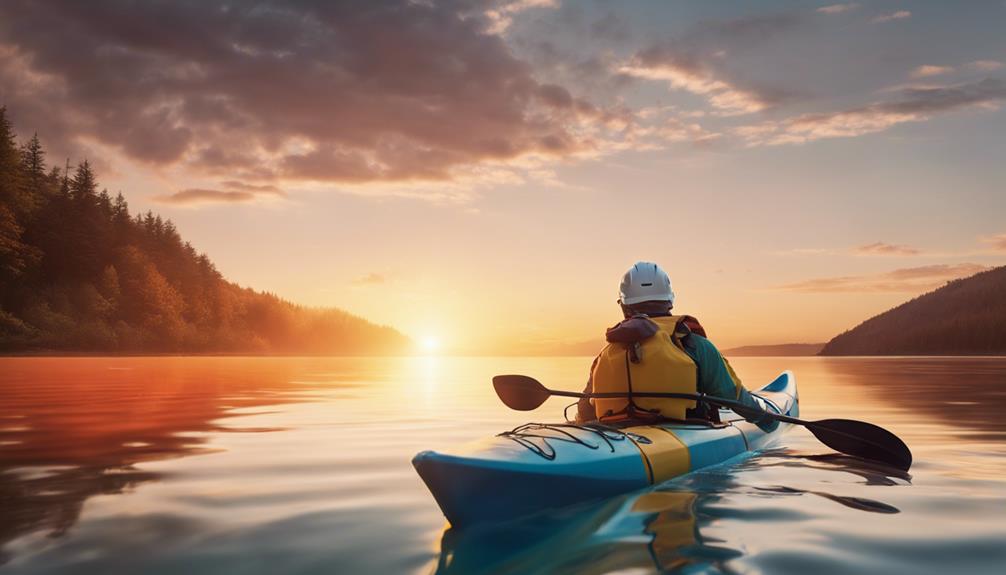Thinking of hitting the waters for your next fishing adventure? Before you cast that line, ensure you're equipped with the essential knowledge of recreational fishing safety.
From understanding proper fish handling to emergency preparedness, these top 4 courses will steer you in the right direction towards a safer and more enjoyable angling experience.
So, are you ready to take your fishing game to the next level?
Importance of Fishing Safety
Understanding the crucial importance of fishing safety is paramount for all anglers, novice or experienced. Safety gear plays a vital role in ensuring your well-being while out on the water. Before embarking on any fishing trip, it's essential to conduct a thorough risk assessment. This involves evaluating the potential hazards you may encounter and taking necessary precautions to mitigate those risks.
When it comes to safety gear, always make sure to have the basics on hand. Life jackets are a non-negotiable item that should be worn at all times, especially if you're fishing from a boat. Additionally, having a first aid kit, a whistle, and a flashlight can prove invaluable in emergency situations. These items may seem simple, but they can make a significant difference in ensuring your safety while fishing.
Risk assessment is another critical aspect of fishing safety. Before heading out, take the time to assess the weather conditions, the water levels, and any potential obstacles in the area where you plan to fish. Understanding these risks allows you to make informed decisions and be better prepared for any unforeseen circumstances that may arise. Remember, staying safe on the water isn't just about luck—it's about being proactive and taking the necessary precautions to protect yourself and those around you.
Choosing the Right Safety Course
When selecting a safety course for recreational fishing, ensure it aligns with your skill level and covers essential topics for a comprehensive learning experience. Start by considering the safety equipment emphasized in the course. A good safety course will guide you on the proper use of life jackets, first aid kits, fire extinguishers, and other essential safety gear. Make sure the course provides detailed information on the most suitable safety equipment for different fishing environments.
In addition to safety equipment, the course should focus on risk assessment. Understanding how to assess potential risks while fishing is crucial for your safety and the safety of others. Look for a course that teaches you how to identify hazards, evaluate risks, and implement strategies to mitigate them effectively. A comprehensive risk assessment module will prepare you to make informed decisions while out on the water.
Ultimately, the right safety course will equip you with the knowledge and skills needed to stay safe during your recreational fishing trips. By choosing a course that covers safety equipment and risk assessment thoroughly, you can enhance your understanding of potential dangers and how to handle them, ensuring a safer and more enjoyable fishing experience.
Online Safety Course Options
Consider exploring the convenience of online safety courses for your recreational fishing education. Online safety courses offer flexibility in learning at your own pace and convenience.
When choosing an online safety course, look for comprehensive coverage of essential topics such as boating regulations and knot tying techniques. Understanding boating regulations is crucial for safe recreational fishing trips. These regulations cover important aspects like speed limits, right of way, and safety equipment requirements while out on the water. By taking an online safety course that includes boating regulations, you can ensure that you're well-informed and compliant with the laws governing water activities.
Additionally, mastering knot tying techniques is fundamental for any angler. Online courses that teach various knots used in fishing, such as the Palomar knot or the clinch knot, can enhance your fishing experience. Proper knot tying ensures that your equipment is secure, decreasing the likelihood of losing a fish due to a poorly tied knot. Online safety courses provide detailed demonstrations and explanations, allowing you to practice and perfect your knot tying skills from the comfort of your home.
Hands-On Safety Training
Enhance your fishing skills with hands-on safety training courses that provide practical experience in handling emergency situations on the water. These courses focus on equipping you with the practical skills necessary to ensure your safety and the safety of others while out fishing. Through hands-on training, you'll learn how to use safety equipment effectively and respond to various on-water emergencies.
During hands-on safety training, you'll have the opportunity to practice using essential safety equipment such as life jackets, flares, fire extinguishers, and first aid kits. Instructors will guide you through scenarios that simulate real-life emergencies, allowing you to apply your knowledge in a controlled environment. By actively participating in these training exercises, you'll gain confidence in your ability to respond calmly and effectively during unexpected situations on the water.
These courses also emphasize the importance of preventive measures to minimize risks while fishing. You'll learn how to conduct safety checks on your boat, identify potential hazards, and create a safety plan for your fishing trips. By developing these practical skills, you'll be better prepared to handle emergencies and ensure a safe and enjoyable fishing experience for yourself and your fellow anglers.
Fish Handling and Release Techniques
Mastering proper fish handling techniques is essential for ensuring the well-being of the fish and maximizing their chances of survival post-release. When you're out fishing, it's crucial to handle your catch with care and release them properly to contribute to the conservation of fish populations and the sustainability of the environment. Here are some key fish handling and release techniques to keep in mind:
- Handle with Care: When catching a fish, avoid causing unnecessary harm. Use wet hands or gloves to handle the fish gently, minimizing the removal of their protective slime layer, which can make them more susceptible to infections.
- Keep the Fish in the Water: If possible, avoid taking the fish out of the water. If you need to handle them on land, do it quickly and ensure your hands are wet to prevent the fish from drying out.
- Proper Hook Removal: Use tools like pliers to safely remove the hook from the fish's mouth. If the fish has swallowed the hook deeply, consider cutting the line instead of causing further harm by trying to retrieve it.
- Release with Care: When releasing the fish, support them in the water until they regain their strength and swim away on their own. Avoid tossing them back into the water or handling them roughly, as this can impact their ability to survive post-release.
Understanding Water Safety
To ensure a safe and enjoyable fishing experience, it's crucial to understand water safety practices. When out on the water, being knowledgeable about water rescue techniques can make a significant difference in emergency situations. Familiarize yourself with basic water rescue methods such as reaching, throwing, and rowing to assist someone in need. Remember, staying calm and thinking clearly are essential during a water rescue.
In addition to water rescue, mastering boat navigation is fundamental for a safe fishing trip. Before heading out, always check the weather forecast and familiarize yourself with the water body's layout. Understanding navigational markers, buoy systems, and right-of-way rules can prevent accidents and ensure smooth sailing. Keep a map or GPS on board and know how to use them effectively to avoid getting lost.
Furthermore, wearing a personal flotation device (PFD) at all times is non-negotiable. A PFD can save your life in case of an accidental fall overboard or a boating mishap. Make sure the PFD fits properly and is in good condition. Lastly, never underestimate the power of water currents and always respect the water. By prioritizing water safety practices and being prepared for any situation, you can enhance your recreational fishing experience while staying safe on the water.
Emergency Preparedness for Anglers
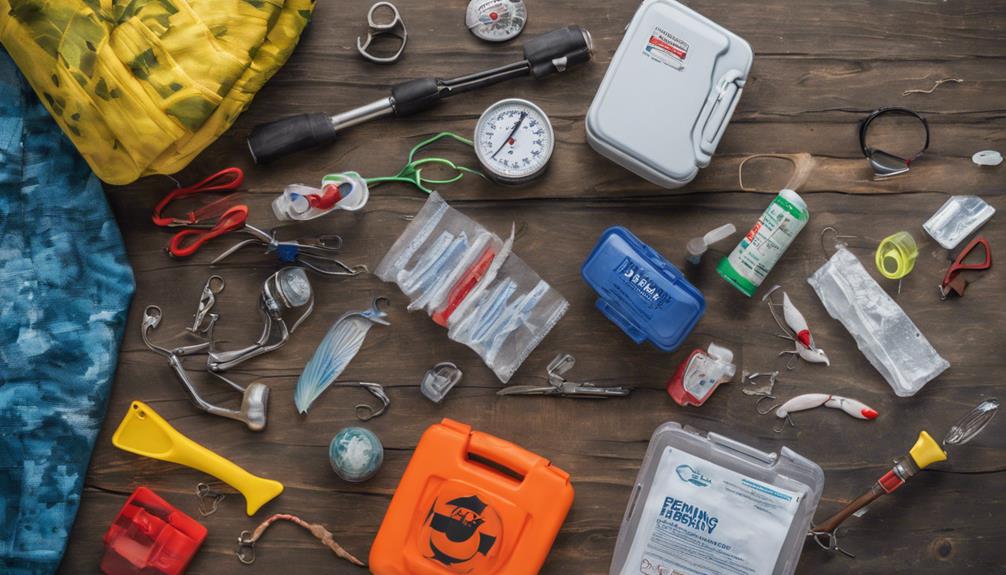
In case of emergencies while fishing, having a well-equipped first aid kit is essential for your safety. As an angler, being prepared for unforeseen situations can make a significant difference in how effectively you can respond to emergencies. Here are some key tips for emergency preparedness:
- Angler First Aid Kit: Always carry a fully stocked first aid kit tailored to the types of injuries commonly encountered while fishing. Include items such as bandages, antiseptic wipes, adhesive tape, scissors, and pain relievers to address minor wounds and injuries promptly.
- Emergency Contact Information: Have a list of emergency contacts readily available, including local emergency services, family members, and friends who can assist in case of an emergency. Ensure your phone is charged and have a backup power source available.
- Knowledge of Emergency Procedures: Familiarize yourself with basic emergency response procedures such as CPR, treating cuts and burns, and recognizing symptoms of heatstroke or hypothermia. Being prepared to act swiftly can help mitigate the severity of an emergency.
- Communication Devices: Carry a fully charged phone or a marine radio to call for help if needed. Additionally, consider investing in a personal locator beacon (PLB) or satellite messenger for remote fishing locations where cellular coverage may be limited.
Safety Certification and Renewal
When it comes to ensuring your safety as an angler, obtaining and maintaining your safety certification is crucial. The certification process involves completing a safety course that covers essential topics such as water safety, basic first aid, and emergency procedures. These courses are designed to equip you with the knowledge and skills needed to handle different situations that may arise while fishing.
In addition to the certification process, it's important to be aware of the safety equipment requirements. This includes having personal flotation devices (PFDs) for each person on board, a sound-producing device like a whistle, and visual distress signals. Ensuring that you have the necessary safety equipment on your boat can make a significant difference in emergency situations.
To maintain your safety certification, most courses require periodic renewal. This may involve taking a refresher course or passing a renewal exam to ensure that you're up to date on the latest safety protocols and procedures. By staying current with your certification, you aren't only prioritizing your own safety but also that of others who may be fishing with you.
Frequently Asked Questions
What Are Some Common Injuries That Recreational Fishermen May Encounter While Out on the Water?
When you're out on the water fishing, common injuries you might encounter include cuts from fish hooks, burns from handling hot equipment, and slips leading to falls.
To prevent these, always handle gear with care, use protective gloves, and watch your step on wet surfaces. Having a safety gear checklist and wearing appropriate attire can help keep you safe and avoid these mishaps while enjoying your fishing adventures.
Are There Any Specific Regulations or Guidelines for Fishing Safety That Vary by Region or Location?
When it comes to fishing safety, you need to be aware of regional regulations and safety guidelines that vary depending on where you are. These rules can cover things like required equipment and specific practices to follow.
It's important to stay informed and comply with these regulations to ensure a safe and enjoyable fishing experience. Keep an eye out for emerging technologies that can also enhance your safety while out on the water.
How Can Fishermen Ensure They Are Properly Equipped With the Necessary Safety Gear Before Heading Out to Fish?
Before heading out to fish, make sure you have all the necessary safety gear. Conduct a thorough inspection of your equipment to ensure everything is in good working order.
Check that you have life jackets, a first aid kit, a whistle, and any other required safety equipment. It's also crucial to have proper training and certification to handle emergencies effectively.
Stay safe on the water by being prepared and knowledgeable about fishing safety.
Are There Any Emerging Technologies or Advancements in Fishing Safety That Anglers Should Be Aware Of?
When it comes to fishing safety, staying informed about emerging technologies is key.
Wearable technology and remote monitoring devices are making waves in the fishing world, helping anglers stay safe on the water.
Emergency response and communication devices are also becoming more advanced, providing peace of mind in case of any unforeseen situations.
What Are Some Tips for Safely Navigating Different Types of Water Bodies Such as Lakes, Rivers, and Oceans While Fishing?
When fishing in lakes, rivers, or oceans, practice good boat etiquette to avoid collisions and conflicts. Stay aware of the weather conditions to prevent getting caught in dangerous situations. Always follow safety guidelines and regulations for each type of water body.
Conclusion
Now that you've learned about the top 4 recreational fishing safety courses, you can confidently enjoy your time on the water knowing you have the knowledge and skills to stay safe.
Remember to always prioritize safety and be prepared for any situation that may arise while fishing. By taking a safety course and staying informed, you can have a fun and enjoyable fishing experience every time.
Stay safe out there and happy fishing!
